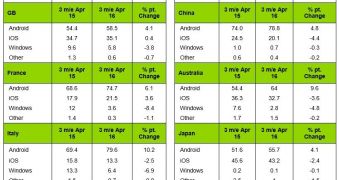The latest statistics provided by Kantar for the three-month period ending April 2016 bring good news for iOS, but not necessarily in a way that Apple would be excited about.
Specifically, while iOS continued to decline in markets around the world and Android to gain ground, the growth recorded by Google’s mobile platform has slowed down, so even though the gap between the two operating systems is extending, it’s not happening at the same rate anymore.
Kantar claims that Android and iOS are fighting over the Windows Phone userbase that’s jumping ship, but until now, the majority of users who are switching from Microsoft’s operating system seem to choose Android.
“In Europe and the US, the smartphone market is approaching saturation, and future successes for either of the two dominant ecosystems will come chiefly from drawing customers away from the other. Windows phones exiting the market, this battle will only intensify,” Lauren Guenveur, Consumer Insight Director for Kantar Worldpanel ComTech, points out.
For Android-Google and iOS-Apple, this will mean not only looking to new markets where smartphone penetration has not yet peaked, such as India, and Latin America, but also to new services and products.”
No decline for Android
In terms of market share, Android remains the leading platform pretty much all over the world, and it even continued to grow in the aforementioned period.
In the United States, for instance, Android dominates the market with a share of 67.6 percent, up 5.2 percent from the same period one year before, while iOS is second with 30.7 percent, down 2.5 percent.
In the United Kingdom, Android is also the leading platform with 58 percent, up 4.1 percent, and iOS is the runner-up with 35.1 percent, this time, up 0.4 percent.
The biggest drop experienced by iOS was in China, where it lost 4.4 percentage points to eventually settle at 20.1 percent, while the biggest growth was posted in France, where it experienced an increase of 3.6 percent to 21.5 percent.
On the other hand, Android experienced absolutely no decline in the world’s biggest markets and scored a growth of no less than 10.2 percent in Italy, where it’s powering 79.6 percent of the phones in the country.
Apple’s recent WWDC announcements, however, are expected to help iOS return to growth, and the arrival of the iPhone 7 in September could also be one of the main catalysts for this switch of trends.

 14 DAY TRIAL //
14 DAY TRIAL //